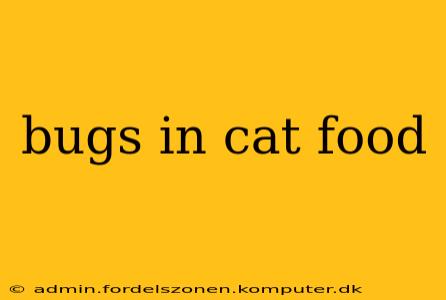Finding bugs in your cat's food is understandably alarming. No one wants to feed their beloved feline something contaminated. This comprehensive guide explores the potential sources of insect infestations in cat food, how to identify contamination, and what steps to take to ensure your cat's safety and well-being.
What Kinds of Bugs Can Be Found in Cat Food?
Several types of insects can infest cat food, both before and after it reaches your home. These commonly include:
- Weevils: These small, brown beetles are a frequent culprit. They lay eggs in grain-based ingredients, and the larvae can survive even during the manufacturing process.
- Moths: Pantry moths are attracted to the smell of stored grains and can lay eggs in opened bags or containers of cat food. Their larvae can then feed on the food itself.
- Other Insects: Occasionally, you might find other insects like mites or grain beetles, depending on the storage conditions and the ingredients of the food.
How Can I Tell if My Cat Food Has Bugs?
Careful inspection is crucial. Check your cat food regularly for:
- Visible Insects: Look for adult beetles, moths, or larvae crawling in the food.
- Insect Fragments: Small pieces of insects, exoskeletons, or webbing might indicate an infestation.
- Unusual Odors: A musty or unpleasant smell can signal spoilage or insect activity.
- Unusual Texture: Clumps or unusual changes in texture might indicate insect activity.
What Should I Do If I Find Bugs in My Cat Food?
If you discover bugs in your cat's food, take immediate action:
- Discard the Contaminated Food: Do not feed this food to your cat. Dispose of it immediately and thoroughly clean the storage area.
- Inspect Other Food: Check all other pet food items for signs of infestation. It's best to discard any opened bags or containers that show even minor signs of bugs.
- Clean the Storage Area: Thoroughly clean your pantry or storage area with soap and water. Pay special attention to cracks and crevices where insects might hide.
- Contact the Manufacturer: Report the issue to the cat food manufacturer. They may offer a refund or replacement. Keep the contaminated bag as evidence.
- Monitor Your Cat: Watch your cat for any unusual symptoms, such as vomiting, diarrhea, or changes in appetite. Contact your veterinarian if you notice anything concerning.
Is it Harmful if My Cat Eats Bug-Infested Food?
While a small amount of insect contamination might not cause immediate harm, large infestations can introduce bacteria and parasites that can make your cat sick. The most significant risk is the potential for allergic reactions or gastrointestinal upset.
How Can I Prevent Bugs in Cat Food?
Prevention is key:
- Proper Storage: Store cat food in airtight containers in a cool, dry place. Avoid storing it near sources of heat or moisture.
- Regular Inspection: Check your cat food regularly for signs of infestation.
- Buy Small Quantities: Purchase smaller quantities of food to reduce the risk of prolonged storage and infestation.
- Rotate Stock: Use older bags of food before opening newer ones.
Are Certain Types of Cat Food More Prone to Bugs?
Dry cat foods, especially those containing grains, are more susceptible to insect infestations than wet foods. This is because insects are attracted to grains and other dry ingredients.
What if My Cat Has Already Eaten Some Bug-Infested Food?
If your cat has already eaten some bug-infested food, monitor them closely for any symptoms of illness. If you notice anything unusual, contact your veterinarian immediately.
Remember, preventing bug infestation is much easier than dealing with it after it happens. By following these tips, you can help keep your cat's food safe and healthy.
